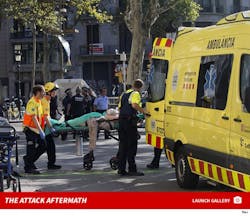Yet another jihadist terror attack, again with a vehicle used as the weapon of choice to mow down innocent lives in a major metropolitan city.
We saw it happen with a truck in Nice, France, last year, with over 84 dead and hundreds injured as a result.
Yesterday, we saw something similar occur in Barcelona, Spain; an Islamist terrorist using a van to plow into a crowd – many of them tourists – leaving 14 dead and over 100 injured in his wake.
And further rubbing salt into that gaping Spanish wound, a second vehicular terror attack took place in the coastal resort town of Cambrils shortly after than van attack – this time with a car – ending in a violent shootout with police that left five terrorists dead.
It’s of course disturbing and frightening that vehicles of all stripes – but especially ones with larger GVWs – are being used by terrorists to commit mass slaughter.
Such heinous attacks take the motorized equipment we rely upon in our everyday lives for transporting goods and people (and often for granted at that) and turn them into mass killing machines.
We’ve known for some time, of course, that commercial trucks can be “weaponized” to varying degrees, though the threat remains low that vehicles such as fuel tanks will be converted into rolling bombs.
Yet the Barcelona attack is a stark reminder that we cannot be complacent; that we cannot simply relegate the trucks surrounding us to the background noise of daily living anymore.
“The uncomfortable reality is that few counterterrorism laws or measures can address the weaponization of everyday life due to the unrelenting call to terror,” noted the Soufan Group following the attack in Nice last year.
“Current counterterrorism capabilities are not designed to prevent attacks like these,” the firm said. “Absent tell-tale communications or travel—or alerting behavior beyond the merely ‘suspicious’—there is little authorities can do to detect and deter attacks of this nature. Such attacks can be considered intentionally spontaneous, in that they take some forethought, but little to no planning or training. The results are mass-casualty terrorist attacks.”
At that time, the Soufan Group noted that cities should think about embedding even more security measures into the fabric of “normal life,” such as barriers and bollards to block vehicle traffic from pedestrian zones.
The nature of these "inspired attacks," however, "broadened the target zone to encompass all public and private spaces,” the Soufan Group stressed.
“Just as terror alerts advising the public to be on the lookout for ’something’ are ineffective and possibly counter-productive, efforts to harden cities against these attacks and assaults are problematic because the venue and method of attacks are limitless," they added.
This is also something U.S. security officials have worried about for years.
For example, back in December of 2010, the Department of Homeland Security issued a warning that terrorist groups were looking to launch “vehicle ramming attacks—using modified or unmodified vehicles—against crowds, buildings,” and other places where large groups of people congregate.
Why use vehicles in this manner? Because they provide terrorists with the potential to kill large numbers of innocent people with minimal prior training or experience and with a lower risk of discovery, as no guns or explosives are needed.
It’s a sad and despicable reality that trucking must guard against in our country must keep in mind, as jihadists may one day seek to turn the very equipment the industry uses against us all.




